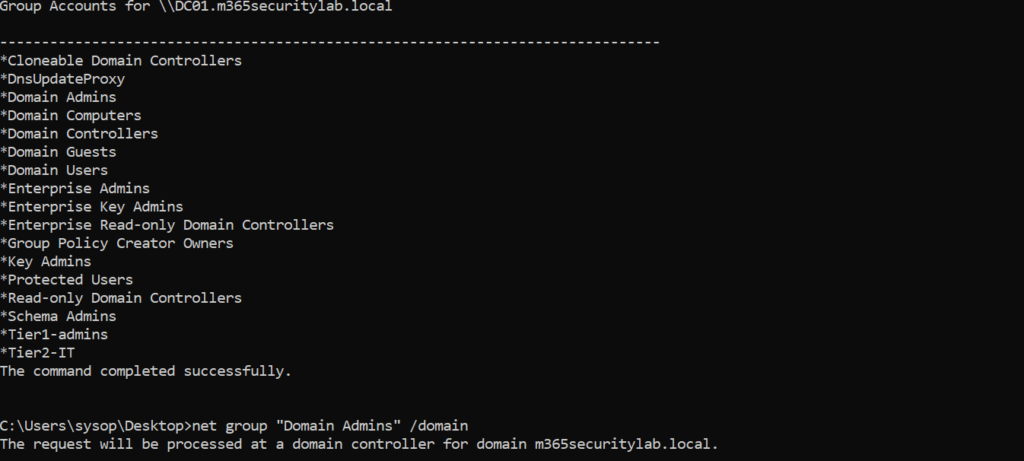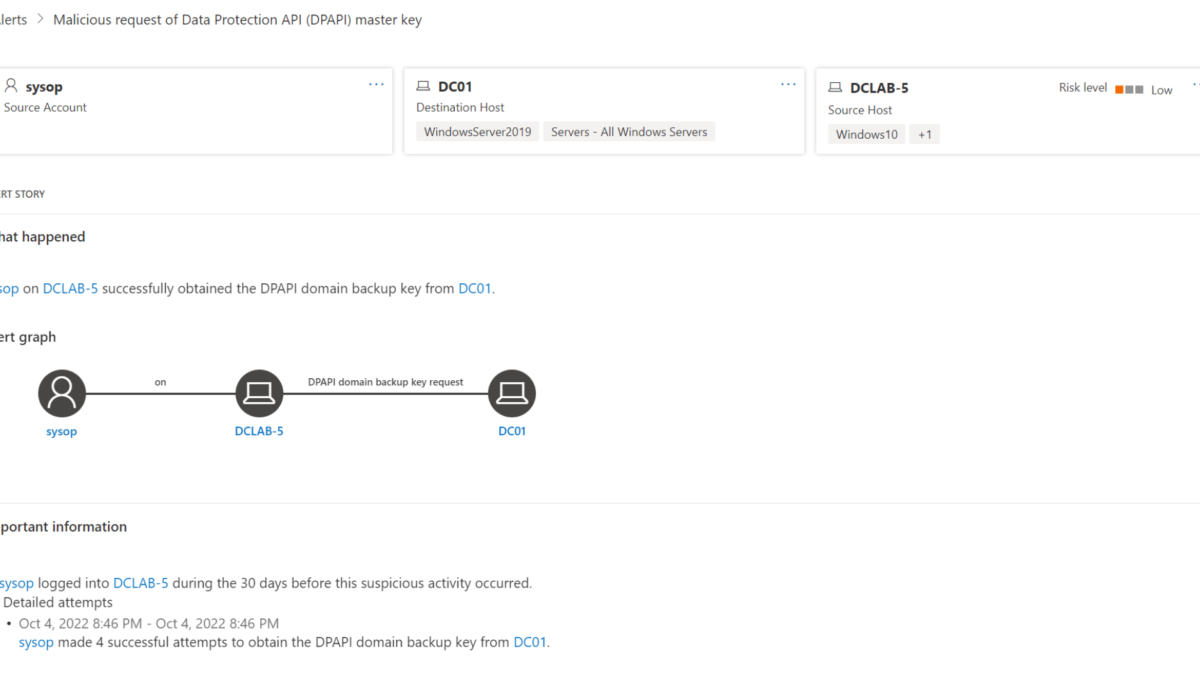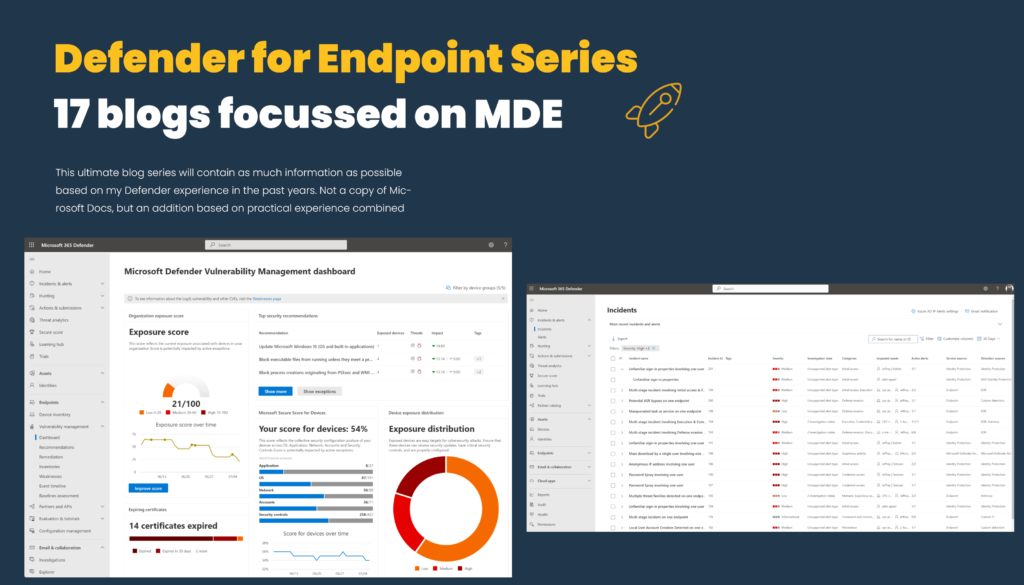Microsoft Defender for Identity MDI (previously called Azure Advanced Threat Protection or Azure ATP) is a Microsoft security solution that captures signals from Domain Controllers. MDI is a cloud-based security solution that leverages on-premises Active Directory signals for detecting identity attacks.
I often see environments where Defender for Identity is installed; however, not under the right conditions with all recommended audit events and permissions.
This blog is focussing on Domain Controllers; ADFS is out of scope. Defender for Identity response actions are explained earlier; Use Microsoft Defender for Identity Response Actions for on-premises AD accounts
| Blog information: Blog published: October 4, 2022 Blog latest updated: October 10, 2022 |
Introduction
Microsoft Defender for Identity works based on four security pillars:
- Prevent
- Detect
- Investigate
- Respond
Defender for Identity monitors the domain controllers by capturing and parsing network traffic and using the Windows events directly from the domain controllers. With the use of profiling, deterministic detection, machine learning, and behavioral algorithms Defender for Identity learns from the environment and enables the detection of anomalies.
Defender for identity security posture assessment can detect vulnerabilities such as,
• Exposing credentials in clear text
• Legacy protocols in use
• Unsecure Kerberos delegation
• Dormant accounts in sensitive groups
• Weaker cipher usage
• Print spooler service in Domain controllers
• Not managing local administrator accounts centrally (Microsoft LAPS)
• Lateral movement paths
• Unmonitored domain controllers
• Unsecure Account attributes
• Unsecure SID history attributes
Components
Defender for Identity consist of the following components:
- Microsoft 365 Defender portal: MDI is integrated into the Microsoft 365 Defender portal
- Defender for Identity sensor: Sensor is installed on Domain Controllers for monitoring all traffic
- Defender for Identity cloud services: Separate environment hosted in Azure. MDI cloud service runs on Azure infra and is connected with the security graph.
Defender for Identity viewed from a simplified view. Image source: Microsoft

The MDI Sensor contains a couple of core functionalities that are critical for getting MDI onboarded. The installed sensor is responsible for the following activity:
- Capture and inspect domain controller network traffic (local traffic of the domain controller)
- Receive Windows Events directly from the domain controllers
- Receive RADIUS accounting information from your VPN provider
- Retrieve data about users and computers from the Active Directory domain
- Perform resolution of network entities (users, groups, and computers)
- Transfer relevant data to the Defender for Identity cloud service
More MDI information can be found here: Microsoft Defender for Identity architecture & What is Microsoft Defender for Identity?
Preparation of the environment
Preparation before deploying any sensors is important. First, we need to match all prerequisites:
License
Licensing is user-based. Common mistake; purchase licenses based on the sensor count. Defender for Identity is user-based counted on the AzureAD users. The following licenses are available;
- Enterprise Mobility + Security E5/A5
- Microsoft 365 A5/ E5/ G5
- Microsoft 365 A5/ E5/ G5/ F5 Security license.
Accounts
- Directory Service account (gMSA recommended)
Network
- Sensors able to reach Defender for Identity Cloud service
- Specific ports allowed from Defender for Identity sensors in the environment
- Network Name Resolution requirements enabled
Audit
- Enable audit policies
- Enable audit policies for Event ID 8004
- Enable audit policies for Event ID 1644
- Enable object auditing
- Enabled optionally exchange auditing
Create Directory Service account (gMSA account)
Defender for Identity supports two types of Directory Service accounts (gMSA and regular user account) – it is heavily advised to use the more secure Group Managed Service Account in the environment. With the use of gMSA DSA Active Directory manages the creation and rotation of the account password.
For more information and multi-forest environments see; Microsoft Defender for Identity Directory Service account recommendations | Microsoft Docs
KDS root key
It is needed to create a KDS root key. When the KDS root key is already available, no further action is required for the KDS root key. The KDS root key is used to generate passwords for AD Managed Service Accounts.
When there is no KDS root key; it is needed to wait 10 hours before creating the gMSA-account.
Validation of the root key is possible using the command: Get-KDSRootKey/ Get-KDSConfiguration. For creating the root key use the following PowerShell command:
Add-KdsRootKey -EffectiveImmediately More information: Create the Key Distribution Services KDS Root Key | Microsoft Docs
Create gMSA account
For the gMSA account all domain controllers with the sensor must have managed password permission/right on the gMSA account. This can be created with a custom group/ single entries or default Domain Controller group. For allowing access the PrincipalsAllowedToRetrieveManagedPassword is needed which ensures that all Domain Controllers will be able to retrieve the password for the accounts.
The sensor with the name ( Azure Advanced Threat Protection Sensor) service runs as LocalService. Sometimes when the Log on as a service policy is configured – it is needed to add the gMSA account to the list of accounts that can log on as a service. NOTE: Only needed for Domain Controllers.
gMSA can be created with the following PowerShell command. Recommended is to use Kerberos encryption type AES256 and optionally -ManagedPasswordIntervalInDays parameter.
New-ADServiceAccount -Name MDIGMSA -DNSHostName MDIGMSA.m365securitylab.local –Description "Microsoft Defender for Identity service account" –KerberosEncryptionType AES256 –ManagedPasswordIntervalInDays 30Get gMSA details:
Get-ADServiceAccount MDIGMSA -Properties * | fl DNSHostName, SamAccountName, KerberosEncryptionType, ManagedPasswordIntervalInDays, PrincipalsAllowedToRetrieveManagedPasswordValidation of the server has the required permission to retrieve the gMSA password can be validated using the following PowerShell command:
Test-ADServiceAccount -Identity 'MDIGMSA'Enable audit events
Defender for Identity relies heavily on Windows Event log entries to enhance detections and provide additional information. It is needed to assign the recommended audit event policy to the Domain Controllers.
Recommended is to not use the built-in Domain Controllers policy and create a separate policy.
Windows Event collection
Go to : Computer Configuration > Policies > Windows Settings > Security Settings -> Advanced Audit Policy Configuration > Audit Policies
Configure the following table for success and failure:
| Audit policy | Subcategory | Triggers event IDs |
|---|---|---|
| Account Logon | Audit Credential Validation | 4776 |
| Account Management | Audit Computer Account Management | 4741, 4743 |
| Account Management | Audit Distribution Group Management | 4753, 4763 |
| Account Management | Audit Security Group Management | 4728, 4729, 4730, 4732, 4733, 4756, 4757, 4758 |
| Account Management | Audit User Account Management | 4726 |
| DS Access | Audit Directory Service Access | 4662 – For this event. Object auditing is needed |
| DS Access | Audit Directory Service Changes | 5136 |
| System | Audit Security System Extension | 7045 |
Example configuration for audit computer account management:

More information: Configure Windows Event collection
Event ID 8004
Go to: Computer Configuration > Policies > Windows Settings > Security Settings ->Local Policies -> Security Operation

Configure the following security policies:
| Security policy setting | Value |
|---|---|
| Network security: Restrict NTLM: Outgoing NTLM traffic to remote servers | Audit all |
| Network security: Restrict NTLM: Audit NTLM authentication in this domain | Enable all |
| Network security: Restrict NTLM: Audit Incoming NTLM Traffic | Enable auditing for all accounts |
Event ID 1644
Event ID 1644 is recommended for LDAP search events. Logging EventID 1644 can result in server performance impact. Important; the resource limitation part of the MDI sensor is not stopping the event collection. Make sure there are enough memory/ CPU and disk resources available.

For Event 1644 is it needed to configure the following registry keys on the domain controllers:
[HKEY_LOCAL_MACHINE\SYSTEM\CurrentControlSet\Services\NTDS\Diagnostics]
"15 Field Engineering"=dword:00000005
[HKEY_LOCAL_MACHINE\SYSTEM\CurrentControlSet\Services\NTDS\Parameters]
"Expensive Search Results Threshold"=dword:00000001
"Inefficient Search Results Threshold"=dword:00000001
"Search Time Threshold (msecs)"=dword:00000001Configure object auditing – 4662 events
For collecting 4662 events – it is needed to configure object auditing on the following objects:
- Descendant Group Objects
- Descendant User objects
- Descendant Computer Objects
- Descendant msDS-GroupManagedServiceAccount Objects
- Descendant msDS-ManagedServiceAccount Objects
Microsoft described the enablement for object auditing for all descendant objects. Use the Microsoft instructions for enabling the recommended set of permissions. Configure object auditing.
Additional configure Exchange auditing when Exchange is currently configured.
Additional Permissions
Defender for Identity requires additional permissions for allowing remote calls to SAM and permissions to the selected object’s container in AD.
Configure SAM-R
For lateral movement path detection, MDI relies on the SAM-R protocol configuration. The queries are performed with the SAM-R protocol.
Important: Apply the remote calls to SAM policy to all computers except domain controllers. The policy can break application that uses AuthZ interface. Source
It is needed to allow the Defender for Identity Directory service account for performing SAM-R. For configuring:
- Go to: Computer Configuration > Policies > Windows Settings > Security Settings ->Local Policies -> Security Operation
- Open the policy: Network access – Restrict clients allowed to make remote calls to SAM
- Allow the earlier created gMSA account
- Deploy the GPO to all computers except domain controllers
Deleted Objects container permissions
gMSA account should have read-only permissions on the Deleted Objects container in AD. This allows Defender for Identity to detect user deletions from your Active Directory.
When not already enabled; enable the recycle bin feature and grant the MDI service account read and list permissions.
For enabling:
Enable-ADOptionalFeature -Identity 'Recycle Bin Feature' -Scope ForestOrConfigurationSet -Target (Get-ADDomain).DNSRoot -Confirm:$false
Adding permissions for the specific gmsaacountname:
dsacls "CN=Deleted Objects,$((Get-ADDomain).DistinguishedName)" /takeownership
dsacls "CN=Deleted Objects,$((Get-ADDomain).DistinguishedName)" /g "$((Get-ADDomain).NetBIOSName)\gmsaaccountname`$:LCRP"
Capacity planning & hardware optimization
NOTE: Run capacity planning before installing the Defender for Identity sensors and after configuring all events. The event set enables more load on the servers.
It is critical to enable enough capacity for Defender for Identity on the Domain Controllers. Microsoft released the Defender for Identity Sizing Tool for checking traffic information.
Run the TriSizingTool.exe for some time and check the results. The Busy Packets/sec value is needed. Map the actual Busy Packets/sec value with the Packets per second recommendation.
For 75-100k packages, the recommendation is 7.50 CPU/ Cores and 13.50 Memory/GB for only the sensor consumption.
More information: Plan capacity for Microsoft Defender for Identity
Hardware
For healthy sensors, the following is recommended:
- No hyper-threaded cores
- Enable the Power Option to High Performance
When running the sensor as a virtual machine, it is recommended to assign all memory to the machine at all times. Memory ballooning or Dynamic Memory is not recommended and can result in health issues.
For Hyper-V ensure that Enable Dynamic Memory isn’t enabled for the VM. For VMware ensure that the amount of memory configured and the reserved memory is the same or configure – reserve all guest memory
More information: Server specifications
IPv4 TSO offload
When using Defender for Identity on VMware virtual machines, sometimes the health alert “Some network traffic is not being analyzed” is visible. For resolving the issue in Vmware it is recommended to disable IPv4 TSO Offload.
Validate of LSO is enabled:
Get-NetAdapterAdvancedProperty | Where-Object DisplayName -Match "^Large*"When the display value is reporting enabled for the Large Send offload it is recommended to disable LSO. (These actions might cause a brief loss of network connectivity and requires a reboot of the machine)
Disable LSO:
Disable-NetAdapterLso -Name {name of adapter}Network
Defender for Identity requires some network requirements for portal connectivity and internal connectivity.
Important is correct connectivity for internal ports and localhost ports. Microsoft explains are required ports here; Defender for Identity Ports | Microsoft Docs.
Network Name Resolution (NNR)
Network Name Resolution (NNR) is one of the main components and critical for Defender for Identity. NNR is needed for resolving IP addresses to computer names. The sensor looks up the IP address using the following methods part of the NNR:
- NTLM over RPC (TCP Port 135)
- NetBIOS (UDP port 137)
- RDP (TCP port 3389) – only the first packet of Client hello
- Queries the DNS server using reverse DNS lookup of the IP address (UDP 53)
| Protocol | Method | Transport | Port | From | To |
| NTLM over RPC | Primary | TCP | Port 135 | Defender for Identity sensor | All devices on network |
| NetBIOS | Primary | UDP | 137 | Defender for Identity sensor | All devices on network |
| RDP | Primary | TCP | 3389, only the first packet of Client hello | Defender for Identity sensor | All devices on network |
| DNS | Secondary | TCP and UDP | 53 | Defender for Identity sensor | DNS Servers |
Microsoft recommends using all of the available methods; when not possible – use the DNS Lookup method and at least one of the other methods.
The secondary DNS lookup of the IP address is only performed when there is no response from any of the primary methods or there is a conflict in the response received from two or more primary methods.
NNR data is crucial for detecting the following threats:
- Suspected identity theft (pass-the-ticket)
- Suspected DCSync attack (replication of directory services)
- Network mapping reconnaissance (DNS)
More information: What is Network Name Resolution?
Onboard Defender for Identity instance
The Defender for Identity cloud service, available within the U.S., Europe, and Asia, runs on Azure infrastructure. To use the cloud services; go to security.microsoft.com -> Settings -> Identities or go to security.microsoft.com/settings/identities
When opening the identities section for the first time it will create the Defender for Identity instance.
Create Directory account connection
- Go to Directory Sensor accounts
- Click Add Credentials
- Fill in the account name(gMSA account) and domain. Enable the checkbox; Group managed service account when using gMSA. For the domain, it is important to use the full FQDN of the domain where the gMSA account is located.

More information: https://learn.microsoft.com/en-us/defender-for-identity/directory-service-accounts
Onboard Sensor
After connecting the Directory service account it is possible to onboard the first Sensor. Open the Sensors view and click on Add sensor. Download the installer package and copy the Access key.
Important: The access key is only needed during the sensor installation and can be regenerated without any impact. When completed the sensor onboarding – it is recommended to reset the access key by clicking “Regenerate key”

Now we can use the downloaded “Azure ATP Sensor setup.exe” for installing the sensor on the Domain Controller. MDI requires .NET Framework 4.7 or later. When there is no .NET Framework 4.7 installed it will be part of the installation which may require a reboot.
Defender for Identity requires the Npcap driver, for new installation Npcap is part of the installation.
Important to allow network communication from the domain controllers to the Defender for Identity service IPs.





Check of the AATPSensor and AATPSensorUpdater services are running.
Configure Defender for Identity sensor
After onboarding, the sensor is visible in the security.microsoft.com portal. Additional configuration is possible. For each sensor the following options are available:
- Enable delayed updated
- Configure additional network adapters
- Configure description
Delayed update
Defender for Identity releases rapidly new updates and features. When used in production it can be advised to configure a sort of deployment ring for the initial test and larger gradual update process. With the delayed update it is possible to delay the updates automatically.

Sensors not selected for the delayed update are updated automatically. When enabled Delayed update there is a delay of 72 hours.
Description
Add optional a description for the Defender for Identity sensor:

Validate
Validate MDI prerequisites
With the use of the test-MDIReadiness.ps1 script it is possible to detect misconfigured environments. The script will check for Object Auditing, Exchange Auditing, ADFS Auditing, Advanced Audit Policy Configuration/ NTLM auditing/ Power scheme/ Root certificates. Part of the result is the JSON file and HTML file.
The script can be downloaded from GitHub

Validate sensor/ installation
For validating Defender for Identity sensors check the following items:
- Check that the service; Azure Advanced Threat Protection sensor is correctly running
- Validate in the portal of the Defender for Identity sensor is correctly reporting

The following logs can be used for the Sensor validation. Default Location: C:\Program Files\Azure Advanced Threat Protection Sensor\version number\Logs
| Log | Description |
|---|---|
| Microsoft.Tri.Sensor.log | All logs related to the Defender for Identity sensor. |
| Microsoft.Tri.Sensor-Errors.log | This log contains just the errors that are caught by the Defender for Identity sensor. |
| Microsoft.Tri.Sensor.Updater.log | This log is used for the sensor updater process, which is responsible for updating the Defender for Identity sensor |
| Microsoft.Tri.Sensor.Updater-Errors.log | This log contains just the errors that are caught by the Defender for Identity sensor updater. |
Validate data
Validation of data is possible with the use of the security.microsoft.com portal. Use the search user or activity log (filtered for app Active Directory).
The old Defender for Identity portal; https://portal.atp.azure.com/ can be still used for checking devices and other events. Search for users/ computers or other objects:

Health alerts
Check the health alerts. After some time Defender for Identity reports possible health alerts based on the actual configuration. Examples of health alerts;
- All domain controllers are unreachable by a sensor
- All/Some of the capture network adapters on a sensor are not available
- Directory services user credentials are incorrect
- Low success rate of active name resolution
- No traffic received from domain controller
- Read-only user password to expire shortly
- Read-only user password expired
- Sensor outdated
- Sensor reached a memory resource limit
- Sensor service failed to start
- Sensor stopped communicating
- Some domain controllers are unreachable by a sensor
- Some Windows events are not being analyzed
- Some network traffic could not be analyzed
- Some ETW events are not being analyzed
- Sensor with Windows Server 2008 R2: Will be unsupported soon
- Sensor with Windows Server 2008 R2: Unsupported
- Sensor has issues with packet capturing component
For viewing the health alerts go to: Security.Microsoft.com -> Settings -> Identities -> Health issues.

Recommended is to configure the Health issues notification for receiving any new health alerts. Open Health issues notification for the configuration and add the recipient email.

MDI Learning period
Defender for Identity requires a machine learning period. Important to give MDI some time for learning and detection of known behaviors and learning patterns.
MDI uses the following learning period timeframe in days:
| Detection | Learning period in days |
|---|---|
| Network mapping reconnaissance (DNS) | 8 days |
| Security principal reconnaissance (LDAP) | 15 days |
| User and group membership reconnaissance (SAMR) | 28 days |
| Suspected brute force attack | 7 days |
| Suspected Golden Ticket usage | 5 days |
| Suspicious additions to sensitive groups | 28 days starting from the first event |
| Data exfilitration over SMB | 15 days |
| Suspicious VPN connection | 30 days from the first VPN connection, and at least 5 VPN connections in the last 30 days, per user. |
Simulating alerts
For validating of Defender for Identity is correctly working there are some Attack simulations/playbooks explained.
Network mapping reconnaissance (DNS)
Run the following command prompt on a workstation part of the domain:
nslookup
server m365securitylab.local
ls -d m365securitylab.localResult: Alert with the title; Network mapping reconnaissance (DNS)
User and IP address reconnaissance
Download netsess and run the following command prompt on a workstation part of the domain:

NetSess.exe m365securitylab.localResult: Alert with the title; User and IP address reconnaissance (SMB)

User and group membership reconnaissance (SAMR)
Run the following command line on a workstation part of the domain:

net user /domain
net group /domain
net group "Domain Admins" /domain
net group "Enterprise Admins" /domain
net group "Schema Admins" /domainResult: Alert with the title; User and group membership reconnaissance (SAMR)
Malicious request of Data Protection API (DPAPI) master key
Run the following command line on a workstation part of the domain:

mimikatz # privilege::debug
mimikatz # lsadump::backupkeys /system:m365securitylab.local /export Result: Alert with the title; Malicious request of Data Protection API (DPAPI) master key

More attack simulations can be found here: Attack simulations for Microsoft Defender for Identity
Microsoft explains more in-depth attacks in available playbooks for Reconnaissance, Lateral movement, and Domain dominance.
View the available alert overview here: Microsoft Defender for Identity Security Alerts
Sources
Microsoft: What is Defender for identity





thxs Jeffrey! This is what i was lookin for. currently haveing some struggle with gSMA
Hi better late than never!
Awesome Guide Thanks Jeffrey!
@Ruben I found that -PrincipalsAllowedToRetrieveManagedPassword Servername$ was required when creating the gSMA account otherwise you get access Errors when running Test-ADServiceAccount -Identity ‘MDIGMSA’ and the Sensor will not work.
https://learn.microsoft.com/en-us/windows-server/security/group-managed-service-accounts/getting-started-with-group-managed-service-accounts
Hi Jeff
great article. if we are collecting DC security events via AMA agent to sentinel. do we need this solution also to capture AD identity activity?
Hi Kris; Thanks – Defender for Identity is more in comparison with only getting audit logs to Sentinel. MDI is built on top of AI and relies massively on learning period and created detections. See; https://learn.microsoft.com/en-us/defender-for-identity/understanding-security-alerts for the complete security alerts part of Defender for Identity.
Let me know when you need more information.
for best practices , you must install the sensor on a dedicated machine and not on the DC , after you make the port mirorring to forward the network traffic from the DC to this machine ( member of the domain)
Thanks for creating this, Jeffrey. The instructions at Microsoft are quite confusing but your instructions are straight forward!
Does the gMSA need to be added explicitly to the “Restrict clients allowed to make remote calls to SAM” policy? What if that setting is not defined and no users/groups have been added? Should the gMSA be the only account in that case?
HI Jeffrey,
“Defender for Identity is used-based counted on the AzureAD users.” I’m not sure I understand the licensing requirement properly. So, there is no dedicated license just for the sensor required? “All” I need is to have on of the following licensnse assigned to my users?
• Enterprise Mobility + Security E5/A5
• Microsoft 365 A5/ E5/ G5
• Microsoft 365 A5/ E5/ G5/ F5 Security license.
What if I have guest users? Or users without a license from the list above? Could you please help me with this query?
thanks,
Edem